Browning has a way of constantly working design and manufacturing technology changes into their firearms without disturbing their traditional appearance. As an example, the current short recoil A5shotgun has a completely different operating system than the long recoil Auto 5 and all of the controls have been eliminated or modified for improved operation, yet both models carry the distinctive, classic look. The BLR has changed in much the same way, so with a 2016 version in hand, a 1980 version was pulled from the safe for the purpose of comparison; Below – new, left, early, right.
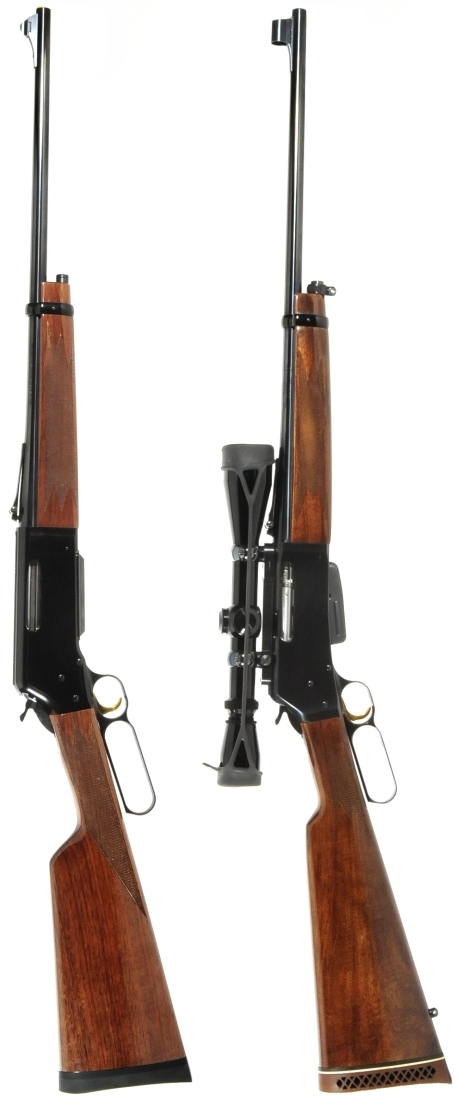
Milestones
Browning BLR, milestone change dates vary dependent upon the company information referenced. In our case, we sourced the Browning Web Site, the Browning Field Service Manual, the Standard Catalog of Browning Firearms, and the Sporting Rifle Take Down and reassembly Guide – J.B. Wood. Majority concurrence set the milestone and associated date.
1971 – First Model BLR Belgium manufacture. Detachable magazine, interrupted thread type locking lugs (2 rows of 4), rotating bolt head with lug seats integral to steel receiver.
1973 – Manufacturing transferred to Miroku in Japan
1981 – Model B-81 BLR revision; flush magazine, slab sided steel receiver and fold forward hammer introduced and applied to all BLR Models
1991 – Long action version added to accommodate long standard and belted magnum cartridges
1996 – Lightning BLR; aluminum receiver with steel barrel extension, to provide locking lugs and barrel mounting threads, splined bolt, 6 lug rotating bolt head.
2003 – WSM cartridges capability was added
2007 – Model BLR Lightweight Takedown was introduced.
The nomenclature ’81 or B-81 was applied to all BLR rifles produced after 1981 and, for a time was applied to both straight cut and pistol grip models. This has since become the division between straight cut, ’81 BLR, and pistol grip, BLR, butt stocks. All current BLR versions have aircraft aluminum receivers, even those with stainless steel barrels and stainless like finish.
Bolts and receivers
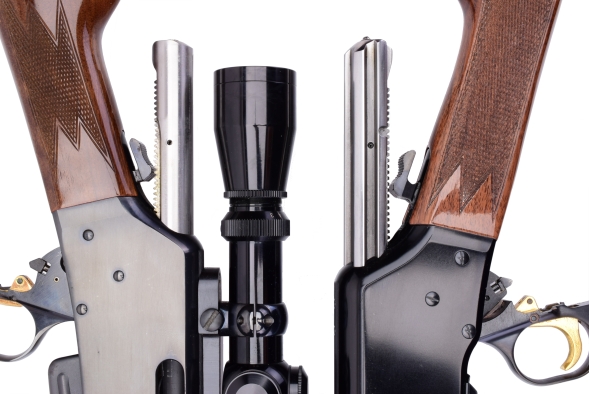
Where early BLRs had a round bolt, post ’96 BLRs with aluminum receivers have a bolt that is splined to the receiver. Both type open and close their respective bolts with a combination of a rack, internal curved rack and spur gears. It is the combination of gear actuation and rotating bolt head, and current generation’s bolt that makes this action stout enough to routinely handle the nearly 64,000 PSI generated by Winchester Short Magnum cartridges.
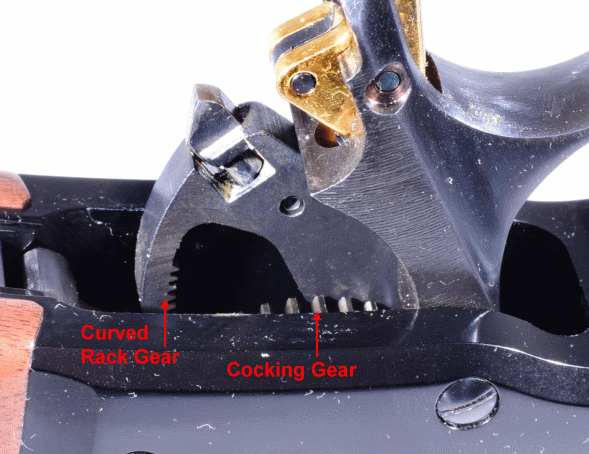
Please excuse the dust and over exposure, I went for the illustration rather than the art as I was not skilled enough to capture both. The cocking gear is nothing more than a small and large diameter spur gear. The small gear is driven by the rack gear that is integral to the lever, and the large gear drives the rack gear on the underside of the bolt.
Below, the lug seats can be seen through the ejection port in the early BLR. The steel receiver is scalloped to reduce weight.

Above, the current lightweight ’81 with aluminum receiver has raised slab sides, the ejection port is shortened to provide room for the steel barrel extension and only the horizontal grooves that locate the bolt, not the lug seats are visible.
Below, with bolts closed, the early BLR’s bolt head is still visible in the ejection port, the new ’81 only shows the bolt flutes that key to the aluminum receiver. The early model ejection port is 2 3/4″ long, while the new receiver’s port has been reduced by 1/4″ in length.
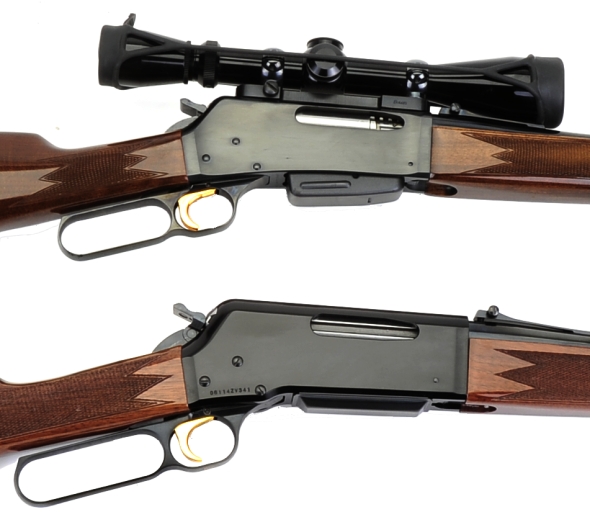
A couple of other notable differences. The small of the stock on the new ’81 is longer as is its lever’s finger loop. Also the receiver bottom is cut straight from forearm to lever pivot and the magazine is pretty much flush.
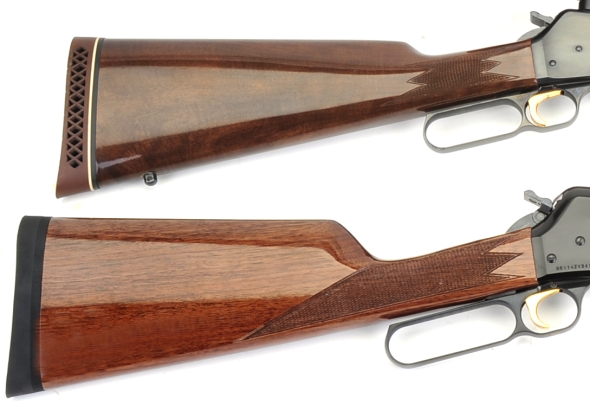
Extending the small of the new ’81 to 4 3/4″ from the original stock’s 3″ exaggerates the new stock’s geometry well beyond actual differences. In reality both have the same 13 3/4″ length of pull. The new stock drops 7/8″ at the heel. The original stock drops 1″ at the heel. Drop is in reference to bore centerline. The early hard pad has been replaced with a modern resilient rubber pad; not a big deal with 243 Win chamber, but a nice touch for the magnum chambers and similar.
Folding forward hammer…
All Browning BLRs, regardless vintage, have an inertial firing pin system; when struck, the mass of the firing pin propels it forward, compressing the firing pin spring and striking the primer of a chambered round. The firing pin then retracts back into contact with the hammer so that unless struck, the firing pin does not protrude beyond the breech face.

The early hammer, far left, is a one piece design and half cock is the safe position when a round in the gun’s chamber. The current hammer design, implemented in 1981, in the second frame and third frame is a two piece design. When set at half cock position, the hammer can be pushed forward so that it will rotate down below the firing pin and next on a solid surface of the bolt. If you look closely, you’ll see the early hammer has a flat below the radius, the newer design has two differently angled flats.
There is a difference between early and ’81 firing pins and the current ’96 design. The early inertial firing pin is solid body and 0.242″ in diameter. The newer design has a hollow shank firing pin that is 0.310″ in diameter, and center striking surface, or “Inertia slide center”, that reduces the striking surface to 0.195″ which provides a great parking space for the fold forward hammer.
Other differences? The early model was supplied with a hooded front sight and front and rear sling swivels. Early steel receiver BLRs have conventional barrel – receiver threads and may be rebarreled traditionally. Aluminum receiver BLRs have a press fit steel receiver insert / barrel extension which requires special tooling when rebarreling. As an example, Wild West Guns, Alaska/Las Vegas rebarrel current generation BLRs, providing some very serious magnum chambers.
|
Early and Current Browning BLR Models |
||
| Model | BLR | BLR Lightweight ’81 |
| Point of Origin | Miroku, Japan | |
| UPC # | – | 023614240631 |
| Type of Action | Lever | |
| Caliber | 243 Winchester | |
| Magazine Capacity | 5 | 4 |
| Magazine Type | Detachable Box | |
| Barrel Length | 20″ | |
| Barrel Material | Alloy Steel | |
| Barrel Finish | Black Oxide | |
| Rifling Twist Rate | 10″ | |
| Receiver Material | Alloy Steel | Aircraft Aluminum |
| Stock Type | 2 Piece Straight Cut | |
| Stock Material | Walnut | |
| Length of Pull | 13 3/4″ | |
| Drop at heel | 1″ | 7/8″ |
| Front Sight | Ramp & Hood | Ramp |
| Rear Sight | W/E Adjustable | |
| Scope Mounts | Drilled & Tapped | |
| Weight of Firearm | 7 Lbs 2 Oz | 6 Lbs 8 Oz |
| Overall Length | 40″ | |
| Safety | Half Cock | Folding Hammer |
| MSRP | – | $959 |
The current BLR is available in short and long action versions, straight and pistol grip, in the following chambers: 222 Rem, 22-250 Rem, 243 Win, 270 Win, 270 WSM, 30-06 Spfld, 300 Win Mag, 300 WSM, 308 Win, 358 Win, 450 Marlin, 7mm Rem Mag, 7mm-08 Rem, 7mm WSM, and 325 WSM. Barrel lengths are 20″ for standard short action rounds, 22″ for long action standard and WSM cartridges, and 24″ for belted magnums. Something for everyone.
So which is better, old or new….
The answer is… “Yes”, which basically means these are both high quality firearms with the current reflecting evolution based on experience and results. Does one shoot better than the other? At this point I don’t know… but I will. So a short break for some live fire check out, then we’ll be back with Part II.
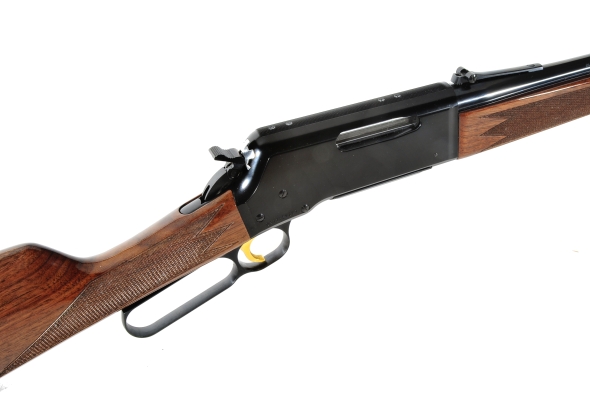

Email Notification